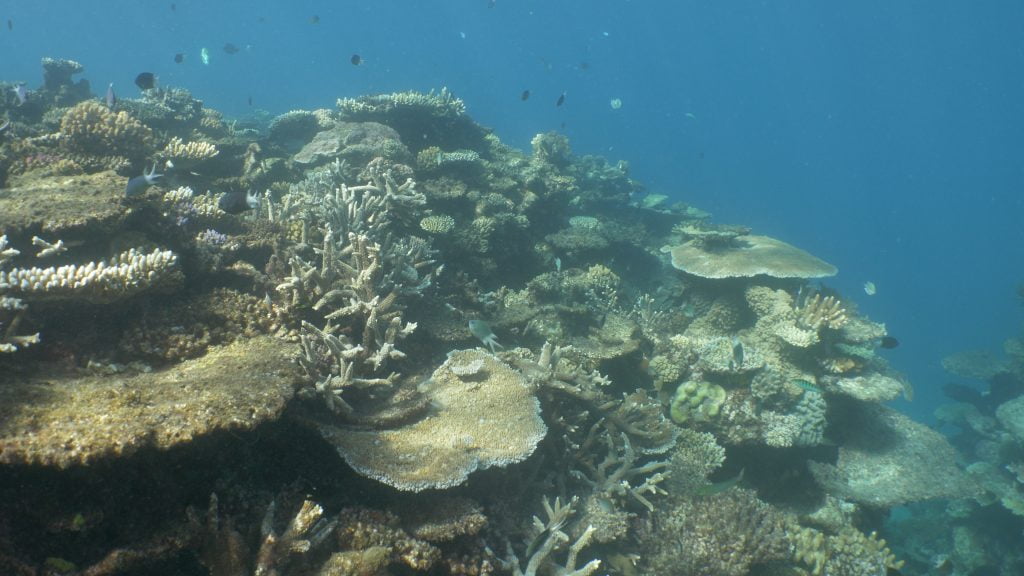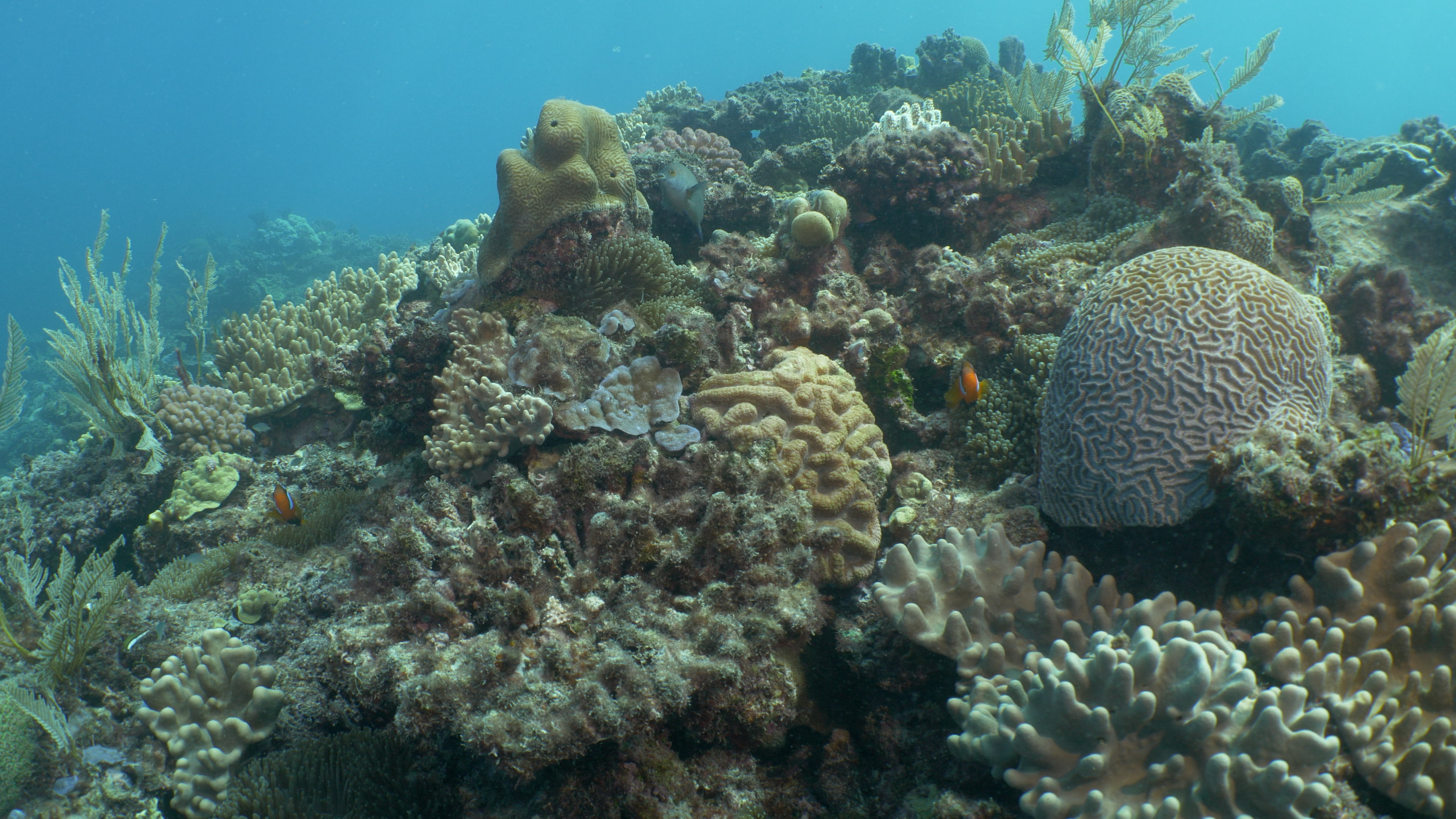Coral reefs are the most extraordinary places, and they are essentially layer upon layer of death. Topped with the most extraordinary diversity of life forms.
Consider Britomart Reef, for example, it is a mid-shelf coral reef 120 kms north of Townsville in the central Great Barrier Reef. The modern reef started to grow about 9000 years ago on a mound of limestone. Limestone is a sedimentary rock composed of calcium carbonate that was the skeleton of coral polyps. Dead coral is not limestone, it has to first undergo cementation.
The limestone at the very bottom of Britomart Reef would have been laid down around 125,000 years ago by hard corals when sea levels were a little higher than they are now.
Then this coral reef went extinct, as sea levels fell more than 120 metres. During the depth of the last ice age (16000 years ago) Britomart Reef would have been a ridge of limestone within a Eucalyptus woodland with the ocean about 64 kilometres further to the east.
Then the ice caps melted sea level rose, and eventually corals started to grow from the dead limestone. The corals hadn’t survived at Britomart, rather the corals recolonised at the beginning of the current geological epoch known as the Holocene.
The modern reef at Britomart is 25 metres thick, with most of this ‘reef mass’ accumulated between 8500 and 5000 years before present on top of the existing platform of limestone. So, the live coral at Britomart is but a thin veneer growing on top of 25 metres of dead coral – on top of the platform of limestone that dates to the Pleistocene.
We know this from coring – holes drilled through this reef back in the 1980s, analysed and radiocarbon dated. According to the paper by David Johnson, Christopher Cuff and Eugene Rhodes published in Sedimentology (volume 31, pages 515 to 529) the top 5 metres at Britomart Reef is classified as ‘fragmented coral boundstone’ that is ‘disoriented, abraded and bored, coral gravel up to 6cm across, which is encrusted and bound by coralline algae.’
That paper was published back in 1984. I dove at Britomart last November and while it was the prettiest of reefs, there were so many dead plate corals. I’m guessing these corals bleached over the last few summers and are now in various stages of decay.
The feature image (photograph at the very top of this blog post) shows a dead, and algal infested plate coral in the foreground. Can you see it? The second image (photograph below) shows dead plate corals as the ridge drops away. In the third image there are two very large dead plate coral to the left, and another towards the bottom of the drop-off. In the fourth picture I’m holding on to a more recently dead plate, now covered in algae.



I’m posting these pictures to show what recently dead plate corals looks like, and to explain that the dead coral extends down 25 metres and represents continuous cycles of death and regrowth over the last 9000 years. This is to inform some discuss about corals at another reef, Pixie Reef. I’ve not been able to find any technical papers about Pixie, but I have started some discussion about Pixie at my Facebook page here https://www.facebook.com/JenniferMarohasyOfficialPage .
We are just starting to discuss the transects photographs in Table 1.1. (specifically the first and second photographs in the first transect) that include patches of what I am fairly sure are dead plate coral.
*******************************
Further reading:
David Johnson et al. 1984. Holocene reef sequences and geochemistry, Britomart Reef, central Great Barrier Reef. Sedimentology, 31, 515 – 529.
The photographs were all extracted from video filmed by Stuart Ireland, and one day it will be turned into a documentary.


 Jennifer Marohasy BSc PhD is a critical thinker with expertise in the scientific method.
Jennifer Marohasy BSc PhD is a critical thinker with expertise in the scientific method.

You wrote:
That paper was published back in 1984. I dove at Britomart last November and while it was the prettiest of reefs, there were so many dead plate corals. I’m guessing these corals bleached over the last few summers and are now in various stages of decay.
Based on every thing else you wrote, this is proof that sea level has recently fallen compared to 5000 years ago.
Coralline limestone is found in many rock formations notably those of the Carboniferous era so coral death is certainly nothing new to people who know what they are talking about.
A Japanese group drilled a coral deposit on a Pacific atoll some 30 years ago, looking for the base of the older now dead coral.
The drillhole log I saw recorded 120m of coral in depth before basal oceanic sediment was intersected. Dating was not done.
Anyone been keeping track of the GBR annual “spawning”
If you are diving on the Reef in November-December and there is a sort-of “brown haze” in the water, it’s probably not an oil spill, but the release of billions of potential coral polyps. This release seems to move like a wave along the reef and may be triggered by water temperature or some other mechanism
The ocean level has certainly had its ups and downs; how else can “coral” at depths greater than 60 feet, where sunlight is decidedly “wan”, be explained. Apart from slow but steady rising and falling, (and lateral movement) of crustal plates.
If the very bottom of the coral “stack” is “limestone”, then there had to be a LOT of mass required to provide the compression on the coral “stack” to form that limestone. Have a peek at the limestone Kaarsts in South East Asia; Thailand, Viet Nam, etc. Enormous pillars of limestone, hundreds of feet tall. What nominal height of coral had to be compressed to achieve that thickness of limestone. What depth of overlying material could have provided such compression, only to be then washed or scraped away.
Is the base limestone currently observed, the result of an overlying sixty feet of coral, or, was it formed a LOT earlier by a seriously ancient reef being buried under a vast mass for the required time. and then re-emerging after the overlay had been removed. Slowly dissolving limestone would provide a handy source of the calcium need by the newly arrived polyps to start reef building again, but ONLY if the limestone substrate and the median ocean level were within the tolerances of the polyps.
Then, there are the marble quarries in North Queensland and alpine Italy.
I always enjoy reading your observation and fact based GBR reports.
Thank you Jennifer !
Ta Jen (you are a great story teller, just like my mum… your passion shines through!) and thanks also to everyone for comments above. I’m the newbie here (last I studied biology was grade 8, never studied much geology…)
So, have I got this right?.. as I understand corals prefer a limited temperature range are sensitive to heat (yes?) Our summer tropical wet season brings cyclones and floods inundating a hot land form, warming the flush of excess flood waters which flow into the cooler ocean, therefore warming the ocean at it’s edges, putting stress on corals (yes?) Killing a % of corals each wet season. More so when there are several cyclones along the QLD coastline within those few months. Layers build up over decades. Successive layers become compressed, forming hard limestone.
So, this reef had a period where it was exposed (when water was held away in ice form) then submerged again, as we see it today. I find it fascinating to imagine it once was a eucalypt forest for a while there. Big changes over big timeframes hey.
In these pics I appreciate the subtle beauty in all of the stages. Especially the white ones before a layer of algae forms. It’s just nature *doing it’s own thing*. Without these fluctuations of ice ages and solar minimums we wouldn’t have these beautiful substances at all. Life would be not as pretty (visually) and timeframes would actually be (pretty darned!) boring.
Thank you sun. Thank you sunspots. Thank you crust plates for shifting around. All in all you bunch give us lots to ponder and learn from.
Very interesting Jennifer, my question would be is there some way that you can arrive at what is a normal turn-over rate for dead and new formed corals. Would this allow one to say that the number of dead corals visible at the present is within the expected norm.
I realise that different corals will have different life cycles and the qustion may not be a simple one. I am no expert so forgive me if I have blundered . .
Regards GeoffW
Wonderful work and great discussion points in the comments . Keep up the good work and the efforts to elucidate the public who cannot do the transects and the view of the ecosystems and history
Jen, I hope you are keeping up to date…
https://realclimatescience.com/2021/04/end-of-the-great-barrier-reef/
…the lies and stupidity are unbelievable.